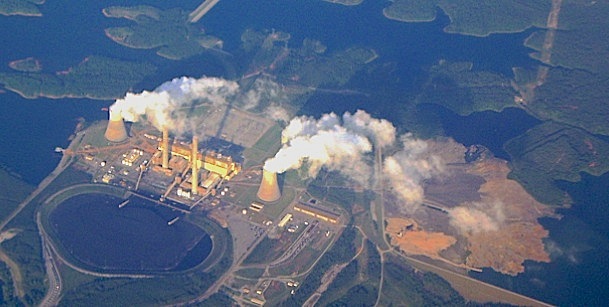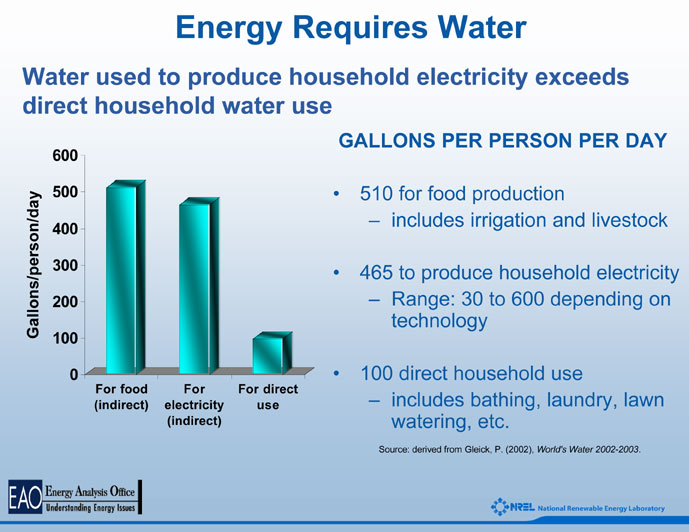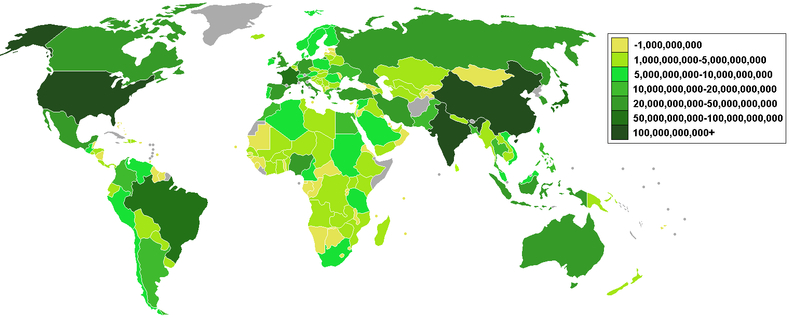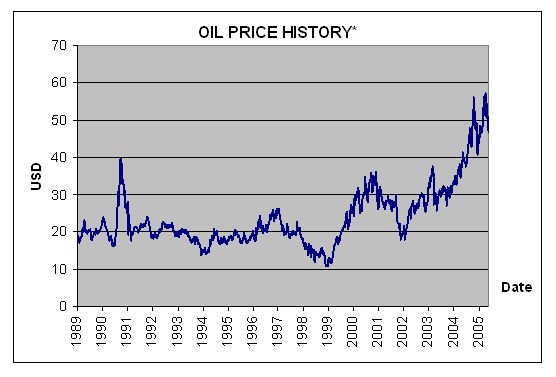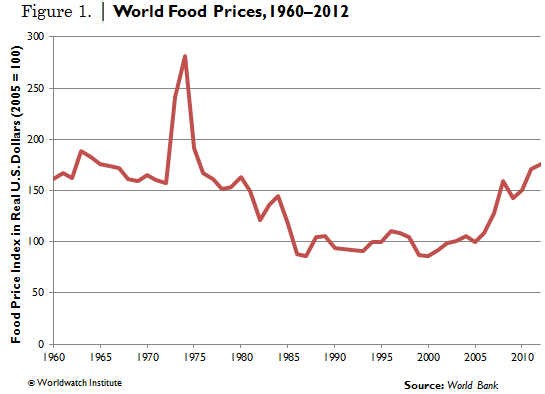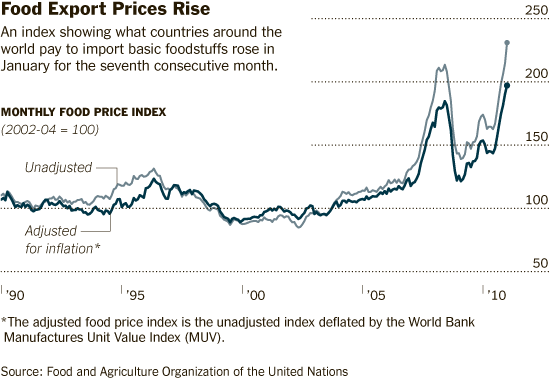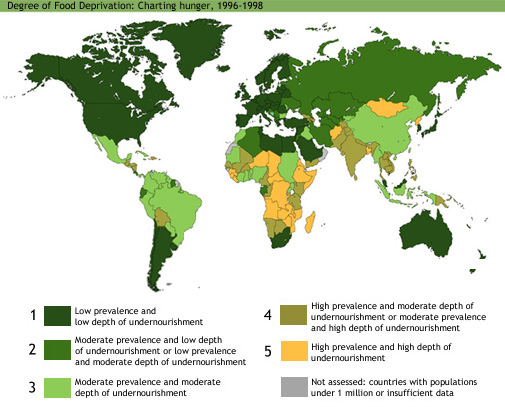 Starvation
Starvation 
The relation of drought, food production, oil prices, and food availability is not always a simple, nor a widely understood interdependency.
Food security is the world's leading problem.
Food price increases in a relatively brief period in 2008, and from 2011–2013 triggered serious sociopolitical disruptions in Africa & Asia.
Origins of food | famines | food needs water & fuel | gasoline | electricity | corn uses | global consumption | Darfur | malnutrition | climate
Where food originates and for whom?
"The United States produces approximately 35 percent of the world's corn and soybean supply, commodities that are 'crucial in the food chain, because they are used for feed stock for animals,' Coleman says."
"There are many large food producers in the world. China is the largest wheat producer, but it is also the largest wheat consumer. What makes the United States unique is that we are the largest exporter, so we produce about 35 percent of the world's corn and soybean supply. Those two commodities are crucial in the food chain, because they are used for feed stock for animals. Around the world you have rising middle classes, a growing demand for meat and protein in the diet, and countries around the world are becoming increasingly dependent on relatively inexpensive food stocks from the United States. When you see a crop failure of the magnitude you have seen this summer, it flows through the whole food chain."
"You're going to see the continuation of [political] instability driven in part by rapidly rising food prices."
"Right now (2012) you have American livestock producers taking their pigs and cattle to the slaughter house because they simply don't have the food to be feeding them. So you're going to see meat prices in the short term in the United States go down, but over the longer term you're going to see rising meat prices; [experts] are predicting already 4 to 5 percent price increases in meat for the next year. That flows through the whole food chain, [to] big-population countries that import a lot of food, such as the Philippines, Afghanistan, Egypt. And when you see rapidly rising food prices, of course it leads to instability. We've seen [this] in the last five years across many of those countries, and you see rising food prices translate almost directly into street protests."
U.S. Drought and Rising Global Food Prices
Interviewee: Isobel Coleman, Senior Fellow and Director of the Civil Society, Markets, and Democracy Initiative; Director of the Women and Foreign Policy Program"
Council on Foreign Relations
Interviewer: Christopher Alessi
August 2, 2012Origins of food | famines | food needs water & fuel | gasoline | electricity | corn uses | global consumption | Darfur | malnutrition | climate
Food | Graphics | Map | Famine | Food-need | Malnutrition | Fuel | Refugees | Prices over 50 years | Causes of
Fuel is needed for water, planting, and harvesting crops, marketing and manufacture of food products, refrigeration, and sale of commodities.
Do you see indicators of fuel use in these depictions?
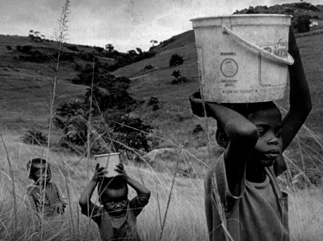 |
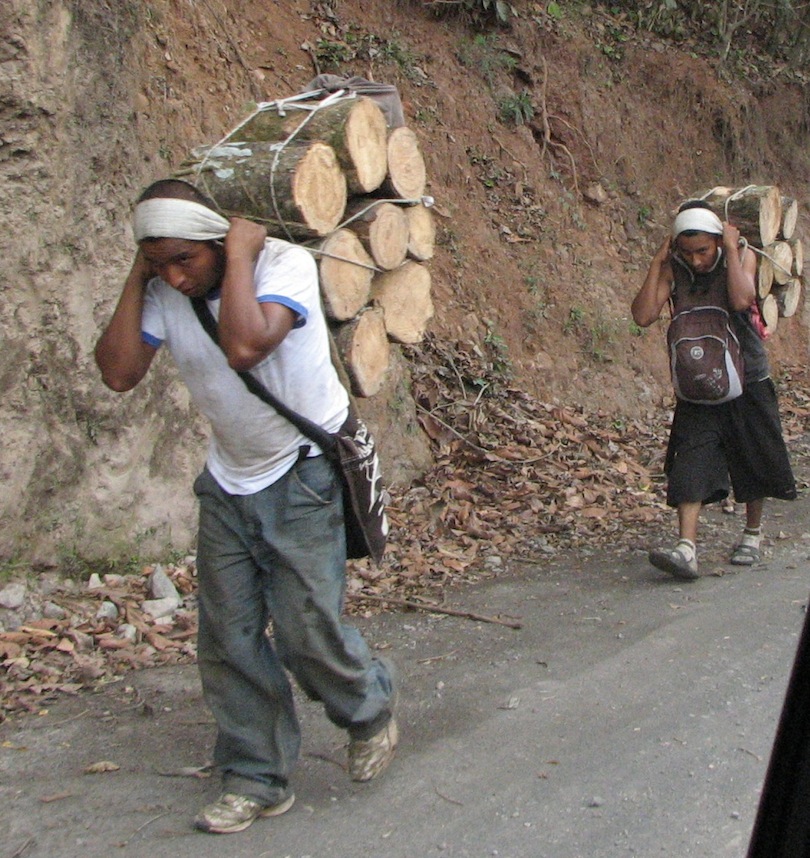 |
 |
African family carries water. |
Guatemalans carrying firewood. |
A horse needs no gasoline, Mexico. |
• As seen in the photograph of a street in Chihuahua, Mexico (on the right above), in developing and western countries including Japan what most people throughout undeveloped parts of the world do is to walk extensive distances for their food, water, and fuel.
• More people in the US, Europe, Japan, and Australia use petrol or gasoline for transporting food as they use electricity to pump water and fossil fuels to supply cooking and heating needs.
Ample water surrounds this coal fire electrical generating plant in the south eastern United States.
Food | Graphics | Map | Famine | Food-need | Malnutrition | Refugees | Prices over 50 years | Causes of
Food requires electricity and gasoline in developed urban nations.
What is energy used for with refernce to food?
√ Farming: food energy for farmers in the form of petrol in the form of gas and diesel for farm equipment, petroleum products used to make synthetic pesticides and fertilizers.
√ Processing: powering buildings and operating machinery to cut, cook and/or freeze food.
√ Packaging: powering buildings and operating machinery to package foods, petroleum products used to make plastics.
√ Food retail: electricity to power store lights and refrigerators
Commercial food service.
√ Household storage and preparation: electricity to power fridge, microwave, stove, gas for stove or oven.
Origins of food | famines | food needs water & fuel | gasoline | electricity | corn uses | global consumption | Darfur | malnutrition | climate
The world population is at an unprecedented level, despite women's revolutionary behavior in raising fewer children.
Food | Graphics | Map | Famine | Food-need | Malnutrition | Refugees | Prices over 50 years | Causes of
Food.
"Corn grain is one of the major foods of the world. Grains in general provide about 80 percent of the world food calories. Today there is a per capita shortage of grains and other foods, exacerbating the serious global malnourishment problem. The World Health Organization reports that 3.7 billion people are malnourished today—nearly 60 percent of the world population. This is the largest number of malnourished ever in history."
David Pimentel, "Corn Ethanol as Energy ", Harvard International Review, October 26, 2009.
David Pimentel, agronomic scientist at Cornell University, has argued for decades that the equivalent of ten calories of oil is necessary to get one calorie of food to an average American's table.
David Pimentel, Ph.D., Marcia H. Pimentel, M.S. Food, Energy, and Society, Third Edition
CRC Press, 2007.
Origins of food | famines | food needs water & fuel | gasoline | electricity | corn uses | global consumption | Darfur | malnutrition | climate
Consumption and production
Energy is related to consumption
Global food crisis, tracking site.
Food Price Watch, July 2012, peak explained.
Food prices 1960-2012, Worldwatch Institute
FAO - Food and Agricultural Organization of the United Nations' Food Price Index, FPI
Food | Graphics | Map | Famine | Food-need | Malnutrition | Refugees | Prices over 50 years | Causes of
Global consumption patterns depend on production.
Origins of food | famines | food needs water & fuel | gasoline | electricity | corn uses | global consumption | Darfur | malnutrition | climate
Agricultural production of countries compared.
Food | Graphics | Map | Famine | Food-need | Malnutrition | Refugees | Prices over 50 years | Causes of
13% of the world population is seriously malnourished and in need of food aid from overseas nations.
Famines in: Somalia and the SAHEL.
4 February 2014: Statement at Rome meeting says 2.5 million people need urgent assistance in region and 20 million are at risk of food insecurity.
Source: The Guardian.
17 Mar 2014: Celeste Hicks: By engaging communities and coordinating agency efforts, Niger hopes to end its perennial battle against food shortage
Source: see, The Guardian
12 Mar 2014: Authorities culpable over failure to provide Tharparkar region with adequate healthcare and infrastructure, claim NGOs. The "Tharparkar District, is one of the twenty three districts of Sindh province in Pakistan. It is headquartered at Mithi. It has the lowest Human Development Index of all the districts in Sindh." Human Development Report for 2014.
"NGOs in Pakistan say the death of at least 132 children in a drought in Sindh province might have been avoided had the government responded sooner. As government aid begins to arrive in the area, local activists have linked the crisis to long-term failures to provide proper health care and infrastructure in the region.
The deaths occurred in the Thar desert, part of Tharparkar district, some 350km (200 miles) from Karachi, which runs up to the border with India."
Source: see, The Guardian
Food | Graphics | Map | Famine | Food-need | Malnutrition | Refugees | Prices over 50 years | Causes of
Origins of food | famines | food needs water & fuel | gasoline | electricity | corn uses | global consumption | Darfur | malnutrition | climate
With petroleum selling at over $87.00 / barrel on 16 October 2007, the cost of food is rising sharply.
Food | Graphics | Map | Famine | Food-need | Malnutrition | Refugees | Prices over 50 years | Causes of
Famine and crop decline per capita are early warning signals.
"The world's croplands are in decline due to the pressure of human activities."
The Food and Agricultural Organization of the United Nations, FAO tracks the international conditions that contribute to the ongoing crisis of food production, nutrition and cost of eating a healthy diet all of which contribute to the stability of countries.
"Over the next 15 years they will gradually cease depressing the growth in cereal demand, which is projected to recover, rising to 1.4 per cent a year by 2015.
Looking further ahead, slower population growth and the levelling off of food consumption in many countries will continue to dampen demand, the growth of which is expected to slow to 1.2 percent a year over the period 2015 to 2030. Nevertheless, the production task facing world agriculture is massive. By 2030, an extra billion tonnes of cereals will be needed each year. Unforeseeable events such as oil price booms, dramatic growth spurts or crises could, of course, alter effective demand over short periods, but will not greatly change the big picture."
Indeed, many have seen the relation among the rising cost of food and the civil unrest that has caused widespread government change in growing nations. The North African and West Asian revolutions referred to as the "Arab Spring," and the intractable three year civil war in Syria are all examples of ties to rapidly rising food prices and the inability of people in poverty to afford basic food to meet their minimum nutritional needs.
Food | Graphics | Map | Famine | Food-need | Malnutrition | Refugees | Prices over 50 years | Causes of
Direct
√ The sharp rise in fuel prices used to to pump water, plant, harvest, and transport food is the most obvious indicator of food insecurity.
√ The necessity to store and convert production of raw materials into food also requires water and energy.
Indirect
Both cropping practices and climate change induced loss of soil and decline in soil moisture are the initial stages in what turns out to be food insecurity.
Origins of food | famines | food needs water & fuel | gasoline | electricity | corn uses | global consumption | Darfur | malnutrition | climate
Darfur
Also in sub Saharan Africa, Mali & Niger
Syria,
• A rural exodus as Drought takes hold of Syria: The Toronto Star
• How Climate Change Helped spark the Syrian Revolution, Arab Spring
South America
South Asia
850,000,000 people do not have adequate nutrition.
Food | Graphics | Map | Famine | Food-need | Malnutrition | Refugees | Prices over 50 years | Causes of
The 20th century began with a population of 1.6 billion people. We entered the 21st century with 6.1 billion people. And in 2007, world population is 6.6 billion. By 2012 the population was 7 Billion.
The increase in the size of the human population in the last half-century is unprecedented.
Food | Graphics | Map | Famine | Food-need | Malnutrition | Refugees | Prices over 50 years | Causes of
Malnutrition
Today over 27,000 children died for lack of food. More than 2 billion people worldwide suffer from deficiencies in micro nutrients (key vitamins and minerals). Thirty-seven percent of the world’s population suffers from anemia and 35 percent are at risk of iodine deficiency.
About 25 percent of preschool-age children suffer from vitamin A deficiency. At the same time, many experts believe there is an “epidemic of obesity,” with as many as one-third of men or women obese in some countries.
Malnutrition is an underlying factor in more than half the deaths of children under five. Malnutrition in children often begins at birth, when poorly nourished mothers give birth to underweight babies. Malnourished children develop more slowly, enter school later, and perform less well. The proportion of severely underweight children is falling, but less than two fifths of the 77 countries with adequate data to monitor trends are on track to reduce poor nutrition and related diseases.
| Progress in reducing child malnutrition has been fastest in East Asia and Pacific, and South Asia. But many countries, especially in Sub-Saharan Africa, lag far behind clearly illustrated in the following graph. Progress in reducing child malnutrition has been fastest in East Asia and Pacific, and South Asia. But many countries, especially in Sub-Saharan Africa, lag far behind clearly illustrated in the following graph. | ||
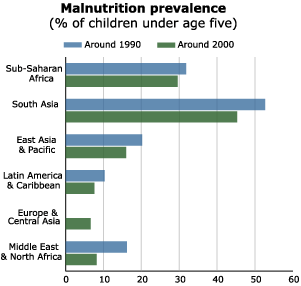 |
.jpg) |
|
Refugee camp in Darfur, South Sudan, Africa. |
||
Food | Graphics | Map | Famine | Food-need | Malnutrition | Refugees | Prices over 50 years | Causes of
| Visualize |  |
|---|---|
|
|
Climate and land use practices: a volatile risk?
The loss of forests and rangelands creates refugees. With displacement due to declining rainfall, damaged soil, and declines in vegetation to capture moisture people begin to migrate away from the drought stricken areas. Refugees in Western Sudan are victims of the twin perils of war and famine due --in part – to changes in the rain belts in sub-Saharan Africa since the 1970s. These people have been displaced by Arab militias with the support of the central Sudanese government.
Graphical sources for presentations.
Food | Graphics | Map | Famine | Food-need | Malnutrition | Refugees | Prices over 50 years | Causes of
Masai women in their village on the Mara plain in Kenya, East Africa [J.V. Siry, 1989].
The immediate causes of a lack of proper and frequent nutrition are insufficient intake of food, and disease that makes it difficult to eat or to absorb food.
However, underlying causes of under nutrition include a lack of income to buy food; inadequate access to food; insufficient food supply due to poor distribution or drought, a lack of access to health services; an unhealthy environment or poor hygiene; and poor eating habits.
The risk of under nutrition is also especially high during fetal development and until about two years of age. Much of the damage under nutrition causes to physical and mental development during this period cannot be reversed.
Influence of famine on genes and epigenesis.
Food price comparisons globally
Food | Graphics | Map | Famine | Food-need | Malnutrition | Refugees | Prices over 50 years | Causes of
Origins of food | famines | food needs water & fuel | gasoline | electricity | corn uses | global consumption | Darfur | malnutrition | climate
This page was created on 16 October 2007 & revised June 21, 2013, & March 29, 2014 & February 7, 2016
– by J. Siry.



